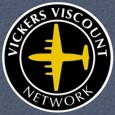United Air Lines Pilot Information
Dimensions
Span: 93ft. 8 in.
Length: 81 ft. 2 in.
Height: 26 ft. 9 in.
Weights - 3 crew, 40 passenger layout (ed. Captial Airlines was 44-48 passengers)
Weight empty (equipped - includes crew, oil, etc.) 36,164 lb.
Maximum payload and catering allowance 12,836 lb.
Maximum 'Zero Fuel' weight 49,000 lb.
Maximum all-up weight 60,000 lb. (ed. Captial Airlines was 63-64,000 lb)
Maximum landing weight 54,000 lb. (ed. Captial Airlines was 57,500 lb)
Engines
Four Rolls-Royce Dart 510 turboprop engines, each driving a four blade Rotol fully-feathering 10 ft diameter
paddle-bladed airscrew. Maximum output per engine 1,550 h.p. plus 365 lb. of jet thrust.
Fuel Capacity
1,950 Imperial Gallons in bag-type tanks forward and aft of main wing spar. Water-methanol system for boosted
take-off: total capacity 75 Imperial Gallons.
Performance
Cruising speed on maximum continuous power at 54,000 lb at 20,000 ft under I.C.A.N. conditions 332 mph. Cruising
speed on recommended power at 54,000 lb at 20,000 ft under I.C.A.N. conditions 321 mph. Rate of climb on maximum
continuous power at 60,000 lb I.C.A.N. conditions flaps up, on four engines 1,280 ft/min at sea level, 640 ft/min at
15,000 ft. Ceiling I.C.A.N conditions at 54,000 lb on maximum continuous power 27,500 ft.
Flying the Viscount
1. Take-off
A smooth take-off to ensure passenger comfort should be always attempted when conditions permit. The take-off technique
will naturally depend upon the local conditions - altitude, runway length, obstacles in the flight path, etc. The
procedure set out below is recommended to meet some of these varying conditions. If an engine fails at the critical
point, the start-to-stop distance at 56,000 lb. A.U.W. will be approximately 1,650 yds, and the distance to 50ft is the
same.
2. Normal take-off
Set the flaps to 20 degrees (43%), run the engines to 12,000 rpm, release the brakes and open the throttles to maximum
revolutions to give a smooth increase in acceleration to full power in the time taken to reach a speed of 50 knots. Keep
the nose-wheel in contact with the ground until the critical speed is reached and unstick at approximately 105 knots,
climb away at 112 knots. Under conditions of aft cg down elevator must be applied to obtain nose-wheel steering power.
3. Take-off from a restricted runway
Set the flaps to 20 degrees (43%), run the engines at maximum take-off revolutions for several seconds before releasing
the brakes and commencing the take-off run. Hold the nose of the aircraft down, nose-wheel on the ground until the
take-off safety speed is nearly reached, air speed at climb-away is practically constant at a speed equal to take-off
safety speed.
4. Take-off technique from high Altitude aerodromes
The technique adopted should be the same as paragraph 2 above coupled with the use of the water/methanol system to
obtain maximum power. The take-off procedure described calls for the minimum of judgment on the part of the pilot, as he
only has to concentrate on one speed. It also provides the best technique for making an accelerate-to-stop since the
nose-wheel is always in contact with the ground to give good directional control and as soon as the throttles have been
closed wheel braking can be applied without having to land the aircraft.
5. Climbing speeds
With all engines operating at 13,000 rpm the economical climbing speed is 150 knots at sea level and the corresponding
rate of climb is approximately 1,000 ft per minute at 56,000 A.U.W. With one engine cut the best climbing speed is 140
knots.
6. Cruising
The recommended cruising setting is 13,300 rpm: the fuel consumption is 0.655 nautical miles per gallon when cruising
at 5,000 ft at a speed of 242 knots, or 1.08 nautical miles per gallon when cruising at 25,000 ft at 264 knots.
Whenever possible cruising should always be carried out at the highest practicable altitude.
7. Air speed Limitations
The normal design speeds are given below:-
Normal Operating Limit Speeds
238 knots IAS 46,000lb
227 knots IAS 47,000lb 0-15,000 ft
220 knots IAS 48,000lb reducing to 190 knots at 35,000ft
Never exceed speed 260 knots IAS 0-15,000 ft, reducing to 210 knots at 35,000ft
Range of speed in turbulent air based on 66 ft per second gusts 155-185 knots IAS
Manoeuvring Speed - 164 knots
8. Landing techniques
The approach should be made at about 1.2 Vs1 (Vs1 = stalling speed) and a flap setting of 40 degrees (85%) with power on
to give a suitable rate of descent. The final approach should be made at about 105 knots with 40 degrees (85%) of flap
at suitable rpm.



